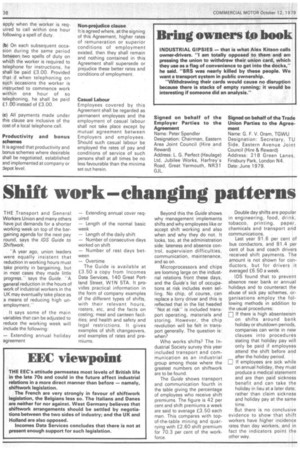Shift work changing patterns
Page 40

If you've noticed an error in this article please click here to report it so we can fix it.
THE Transport and General Workers Union and many others have put demands for a shorter working week on top of the bargaining agenda for the next pay round, says the IDS Guide to Shiftwork.
"A year ago, union leaders were equally insistent that reduction in working hours must take priority in bargaining, but in most cases they made little progress," says the Guide. "A general reduction in the hours of work of industrial workers in the UK may eventually take place as a means of reducing high unemployment."
It says some of the main variables that can be adjusted to reduce the working week will include the following: — Extending annual holiday agreement — Extending annual cover required — Length of the normal basic week — Length of the daily shift — Number of consecutive days worked on shift — Number of rest days between — Overtime The Guide is available at £3.50 a copy from Incomes Data Services, 140 Great Portland Street, W1N 5TA. It provides practical information in the form of company examples of the different types of shifts, with their relevant hours, rosters, etc, and the facts on costing; meal and canteen facilities; and health and safety and legal restrictions. It gives examples of shift changeovers, and examples of rates and premiurns. Beyond this the Guide shows why management implements shifts and why employees like or accept shift working and also when and why they do not. It looks, too, at the administration side: lateness and absence control, supervision difficulties, communication, maintenance, and so on.
Microprocessors and chips are looming large on the industrial relations front these days, and the Guide's list of occupations at risk includes even selling. No chip, of course, can replace a lorry driver and this is reflected that in the list headed ''Not at risk' is included transport operating, materials and storing. However, the chip revolution will be felt in transport generally. The question is: when?
Who works shifts? The Industrial Society survey this year included transport and communication as an industrial group among those where the greatest numbers on shiftwork are to be found.
The Guide shows transport and communication fourth in the table giving the percentage of employees who receive shift premiums. The figure is 42 per cent and shift premiums a week are said to average £3.50 each man. This compares with topof-the-table mining and quarrying with £2.60 shift premium for 70.3 per cent of the workforce. Double day shifts are popular in engineering, food, drink, tobacco, printing, paper, chemicals and transport and communications. .
Last year 91.6 per cent of bus conductors, and 81.4 per cent of bus and coach drivers received shift payments. The amount is not shown for conductors, but for drivers it averaged £6.50 a week.
IDS found that to prevent absence near bank or annual holidays and to counteract the abuse of sick pay schemes, organisations employ the following methods in addition to the usual procedures:
17 If there is high absenteeism on shifts around bank holiday or shutdown periods, companies can write in new clauses into procedures stating that holiday pay will only be paid if employees attend the shift before and after the holiday period. E If employees are sick while on annual holiday, they must produce a medical statement and are then paid sickness benefit and can take the holiday in lieu at a later date; rather than claim sickness and holiday pay at the same time.
But there is no conclusive evidence to show that shift workers have higher incidence rates than day workers, and in fact the indicators point the other way.
























































































































